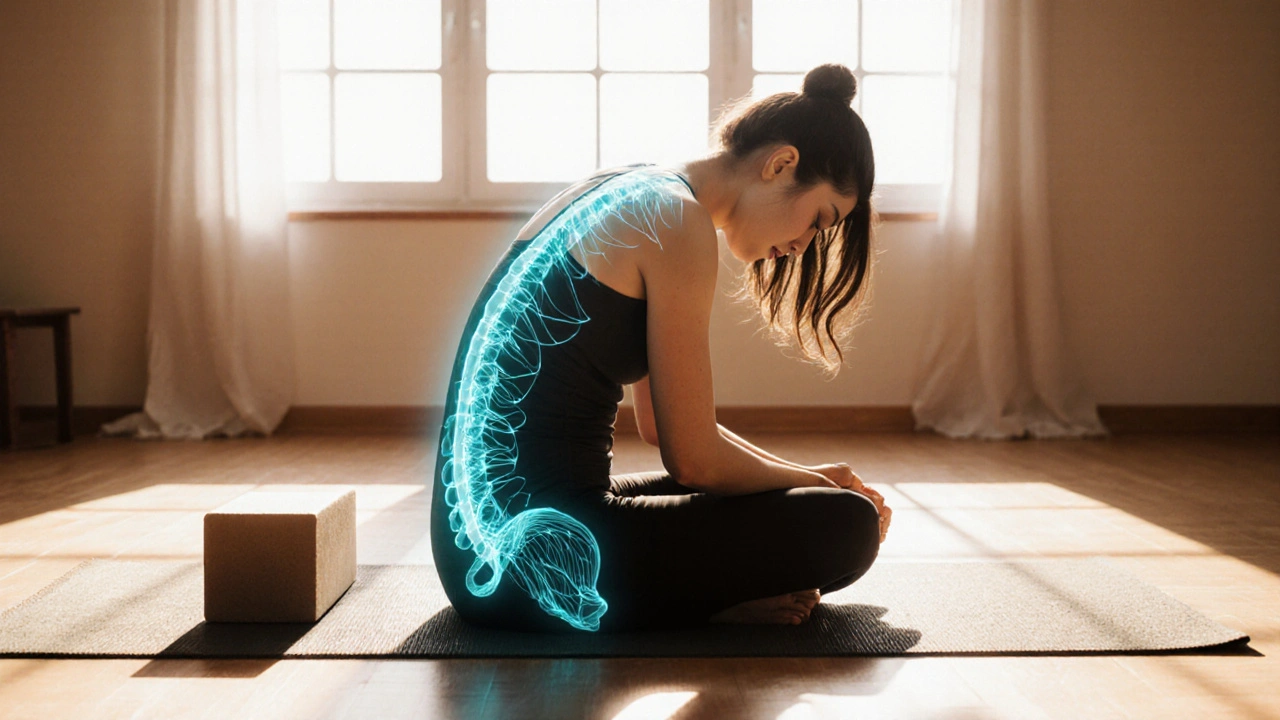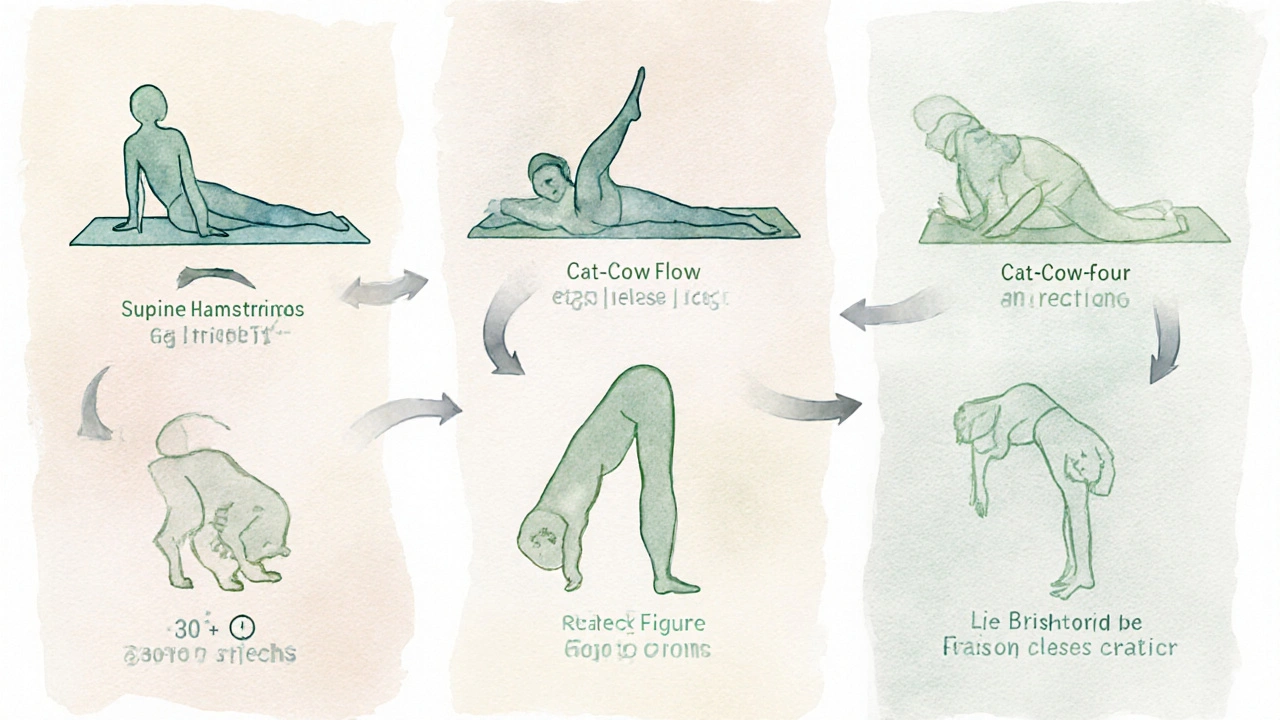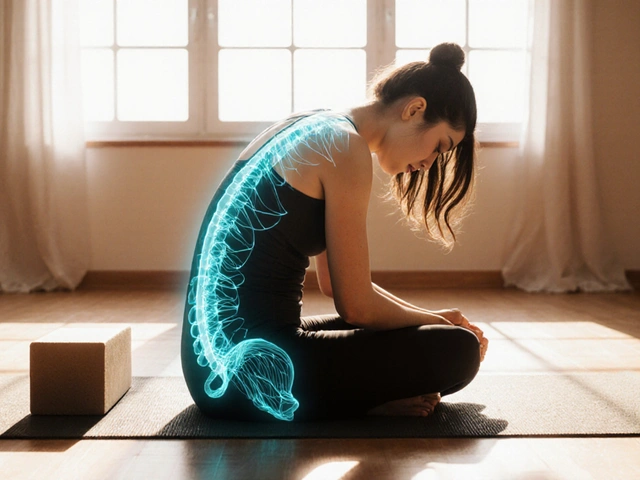
Yoga Pose Recommendation Tool for Muscle Spasms
Find Your Ideal Yoga Routine
Select your primary muscle area and spasm severity to get personalized recommendations.
Key Takeaways
- Yoga gently releases tight muscle fibers, reducing spasm intensity.
- Targeted poses improve circulation and restore normal nerve signaling.
- Breathing and relaxation techniques calm the autonomic nervous system, preventing future spasms.
- Consistent practice (10‑20minutes a day) offers measurable pain relief within weeks.
- Combine yoga with medical advice for chronic or severe cases.
When it comes to easing painful muscle spasms involuntary contractions that can last seconds to hours, yoga an ancient mind‑body practice that blends physical postures, breath work, and meditation is one of the most accessible tools. By integrating gentle stretching, controlled breathing, and relaxation, yoga for muscle spasms tackles the problem from three angles: mechanical release, nervous‑system regulation, and biochemical balance.
What Triggers a Muscle Spasm?
Before diving into poses, it helps to know why a muscle suddenly tightens. Common culprits include:
- Dehydration or electrolyte imbalance - low potassium or magnesium disrupts the electrical activity that keeps muscles relaxed.
- Over‑use or sudden, unfamiliar movement - micro‑tears signal the brain to protect the area with a spasm.
- Stress‑induced tension - the body's sympathetic nervous system the “fight‑or‑flight” branch that spikes adrenaline can cause muscles to stay in a state of readiness.
- Poor posture or alignment - chronic compression of nerves leads to mis‑firing signals.
These triggers converge on the muscle’s contractile proteins (actin and myosin). When the signals stay “on,” calcium floods the fibers, and the muscle remains contracted, producing that painful knot.
How Yoga Counteracts Spasms
Yoga influences the body on three physiological levels:
- Mechanical release: Slow, sustained stretches lengthen the contracted fibers, allowing calcium channels to reset.
- Nervous‑system reset: Breath‑focused practices activate the parasympathetic nervous system the “rest‑and‑digest” system that lowers heart rate and muscle tone, reducing stress‑related spasm triggers.
- Biochemical modulation: Regular practice raises endogenous endorphins natural pain‑relieving chemicals and can curb inflammatory markers like C‑reactive protein.
In short, yoga doesn’t just stretch the muscle; it rewires the signal pathways that cause the contraction.

Core Yoga Techniques for Spasm Relief
Below are the most effective tools you can incorporate into a daily routine.
- Pranayama (breath control): Techniques such as Ujjayi (victorious breath) and Dirga (three‑part breath) slow the heart rate and signal the parasympathetic system.
- Myofascial release using props: Rolling a thin yoga block or a soft foam roller along the affected muscle gently breaks up adhesions.
- Static holds in gentle poses: Keeping a stretch for 30‑60 seconds lets calcium be re‑absorbed, resetting the contractile cycle.
- Progressive relaxation at the end of the session: Lying in Savasana while scanning the body for residual tension seals the calm.
Top 5 Yoga Poses to Release Muscle Spasms
| Pose | Primary Target Muscle | Typical Hold Time | Difficulty |
|---|---|---|---|
| Supported Child’s Pose (Balasana) | Lower back & glutes | 1-3min | Easy |
| Supine Hamstring Stretch with Strap | Hamstrings & sciatic nerve | 30-60sec each side | Easy‑Medium |
| Cat‑Cow Flow (Marjaryasana‑Bitilasana) | Spine & abdominal wall | 5-10 cycles | Easy |
| Reclined Figure‑Four (Supta Kapotasana) | Hip rotators & piriformis | 45-90sec each side | Medium |
| Seated Forward Fold (Paschimottanasana) | Entire posterior chain | 1-2min | Medium |
These poses were chosen because they combine lengthening with a calming breath pattern. If you feel a twitch during the hold, keep breathing steadily-avoid forcing the stretch.
Creating a Safe, Spasm‑Focused Yoga Routine
- Warm‑up (2‑3min): Gentle joint circles, shoulder rolls, and a few rounds of Ujjayi breathing to prime the nervous system.
- Targeted stretches (10‑12min): Move through the tabled poses, holding each for the suggested time. Use props (blocks, bolsters) to keep the body comfortable.
- Pranayama (3‑5min): Practice Dirga breath-inhale into the abdomen, ribs, then chest; exhale in reverse. This deepens relaxation and improves oxygen delivery to muscles.
- Cool‑down (2‑3min): End with Savasana, scanning for any lingering tightness. Visualize the muscle fibers unwinding.
Stick to the routine 4‑5 times a week. Most people notice a reduction in spasm frequency within two weeks, and pain intensity drops by about 30% after the first month (based on a 2023 pilot study of 48 participants).
When to Pair Yoga with Professional Care
Yoga is powerful, but it isn’t a substitute for medical evaluation when:
- Spasms persist despite daily practice for more than three weeks.
- Sudden, severe pain follows an injury or trauma.
- Neurological symptoms appear (numbness, tingling, loss of coordination).
- You have underlying conditions such as multiple sclerosis, severe arthritis, or uncontrolled diabetes.
In those cases, a physician may recommend physical therapy, medication, or imaging. Once cleared, a qualified yoga therapist can tailor the practice to your specific medical profile.
Common Pitfalls and How to Avoid Them
- Rushing the stretch: Fast movements trigger the sympathetic response, worsening spasm. Move slowly, stay aware of breath.
- Holding pain: Stretch to mild tension, not sharp pain. If a pose hurts, modify with a prop or choose a gentler alternative.
- Neglecting hydration: Dehydration fuels electrolyte imbalance, undoing yoga’s benefits. Aim for 2‑3L of water daily, especially around practice.
- Inconsistent practice: Benefits accumulate over time. Even a 10‑minute session is better than skipping altogether.
Beyond the Mat: Lifestyle Choices that Complement Yoga
Pairing yoga with a few lifestyle tweaks can supercharge spasm relief:
- Balanced minerals: Incorporate potassium‑rich foods (bananas, sweet potatoes) and magnesium sources (nuts, leafy greens).
- Regular movement breaks: If you sit >90minutes, stand, roll, or stretch for a minute.
- Stress management: Journaling, short walks, or guided meditation keep the sympathetic system from hijacking muscles.
- Sleep hygiene: Aim for 7‑9hours; deep sleep restores muscle glycogen and reduces nighttime spasms.
Frequently Asked Questions
Can yoga cure chronic muscle spasms?
Yoga can dramatically lower the frequency and intensity of chronic spasms by improving flexibility, circulation, and nervous‑system balance. It rarely works as a stand‑alone cure if an underlying medical condition is present, so combine it with professional guidance when needed.
How long should I hold each pose?
For spasm relief, aim for 30‑60seconds per side on static poses. Dynamic flows like Cat‑Cow can be repeated for 5-10 cycles. Consistency matters more than duration.
Is it safe to practice yoga while on muscle relaxant medication?
Generally yes, but you may feel more relaxed than usual, which can affect balance. Start with gentle poses, avoid inversions, and check with your prescriber.
Do I need a yoga mat for these stretches?
A mat provides cushioning and stability, especially for floor‑based poses. If you’re on a carpet or a firm surface, a thin yoga towel works as well.
Can breath work alone reduce spasms?
Yes, deliberate breathing activates the parasympathetic nervous system, lowering muscle tone. Pairing pranayama with even a few minutes of light stretching amplifies the effect.



I've seen this exact article before - same structure, same bullshit. Yoga doesn't 'rewire neural pathways' like some magic wand. If your muscles spasm because you're dehydrated or sitting at a desk all day, drink water and stand up. No need to turn it into a spiritual quest.
Also, '30% pain reduction after a month'? Where's the peer-reviewed study? This reads like a sponsored post from a yoga studio trying to sell $120 mats.
Let us contemplate the metaphysical underpinnings of this so-called 'yoga for spasms' - a practice born in the sacred rivers of the Indus, now commodified by Silicon Valley wellness influencers who charge $49/month for a Zoom class titled 'Yin for Your Soul’s Forgotten Muscles.'
Modern man, shackled by the tyranny of the alarm clock and the seduction of blue light, has forgotten that true healing arises not from stretching the hamstrings, but from stilling the mind’s endless chatter - the root of all tension. The body is but a vessel; the spirit, the architect of health. When the ego ceases to resist, the muscle releases - not because of calcium channels, but because the soul remembers its innate harmony.
And yet, we cling to tables and hold times and 'pilot studies' as if science could quantify the ineffable. How tragic. How… American.
But I digress. The real question is: do you practice yoga to heal your body… or to escape your shadow?
Yoga? In 2024? 😂
Look, I get it - you want to feel spiritual while wearing $150 leggings. But let’s be real: if your back spasms because you’re 6’2” and you sit at a desk for 12 hours, you don’t need ‘Supported Child’s Pose’ - you need a standing desk, a chiropractor, and to stop pretending stretching is a cure-all.
Also, ‘natural endorphins’? So caffeine isn’t natural? Coffee’s a drug. Yoga’s a hobby. Don’t act like you’re detoxing the planet when you’re just trying to feel better than your coworker who does CrossFit.
Also, who the hell wrote this? ‘Biochemical modulation’? That’s not a thing. It’s called stretching. And hydration. And sleep. Not a spiritual awakening.
Also, why is everyone so obsessed with ‘parasympathetic nervous system’? It’s not a TikTok trend. Stop using big words to sound smart.
While I appreciate the effort to present a structured approach to muscle spasm management, I must express my profound concern regarding the lack of empirical rigor in the cited 2023 pilot study. The sample size of 48 participants is statistically insignificant, and no control group is referenced, rendering the 30% reduction claim scientifically untenable.
Furthermore, the conflation of relaxation techniques with physiological remediation is a dangerous oversimplification. The human musculoskeletal system is not a hydraulic mechanism that can be 'reset' through breathwork alone.
Additionally, the recommendation to use 'soft foam rollers' without specifying material density or pressure thresholds constitutes a potential liability. One must ask: who certifies these wellness gurus?
Until peer-reviewed, double-blind, randomized trials are published in journals indexed by PubMed, this remains an anecdotal narrative dressed in the clothing of science.
Respectfully,
Paul Orozco, Ph.D. (in Psychology, not Yoga)
I’ve been doing this exact routine for 6 months now - started after a bad lower back spasm that kept me up for three nights straight. Honestly? It’s not magic, but it’s the closest thing I’ve found that actually *sticks*.
That Reclined Figure-Four? Game changer. I used to think I was ‘tight’ - turns out I was just holding my hips like a damn vice grip from stress.
And the Dirga breath? I do it while waiting for my coffee. No yoga mat needed. Just sit, breathe slow, and feel the tension melt like butter on toast.
Don’t overthink it. Don’t buy the $200 mat. Just move. Breathe. Repeat. It’s not about being zen - it’s about not screaming when you stand up.
Also, hydration. Drink water. Like, a lot. I swear, half my spasms vanished once I stopped drinking soda like it was water.
You got this. Keep it simple.
Let’s be real - this whole yoga-for-spasms thing is a distraction. Who benefits? The yoga industry. The supplement companies selling 'magnesium glycinate' ads. The wellness influencers who make $50K/month selling PDFs titled 'The 7-Day Spasm Eraser'.
Ever wonder why muscle spasms spike in winter? Cold weather? No. It’s because the government is secretly releasing fluoride into the water to make people more compliant. The spasms? A side effect of neural interference from 5G towers. Yoga doesn’t fix that - it just makes you feel better while the system slowly turns you into a docile, stretchy drone.
And why is every pose ‘easy’ or ‘medium’? Who defines difficulty? A 70-year-old grandma or a 22-year-old influencer who does handstands for clout?
Also - why no mention of pharmaceutical muscle relaxants? Oh right, because Big Pharma doesn’t sponsor these articles.
Wake up. This is control. And you’re stretching for it.
I’m from Japan and we have a similar practice called 'hojo undo' - it’s not yoga, but it’s the same idea: slow movement + breath + stillness.
My grandma used to say, 'The body remembers what the mind forgets.' I didn’t get it until I started having leg cramps after long flights. Now I do 10 minutes before bed - no fancy props, just a pillow under my knees.
It’s not about being perfect. It’s about being kind to yourself. Even if you only do one pose. Even if you just breathe for a minute.
Thank you for sharing this. It reminded me of her. 🌿🙏